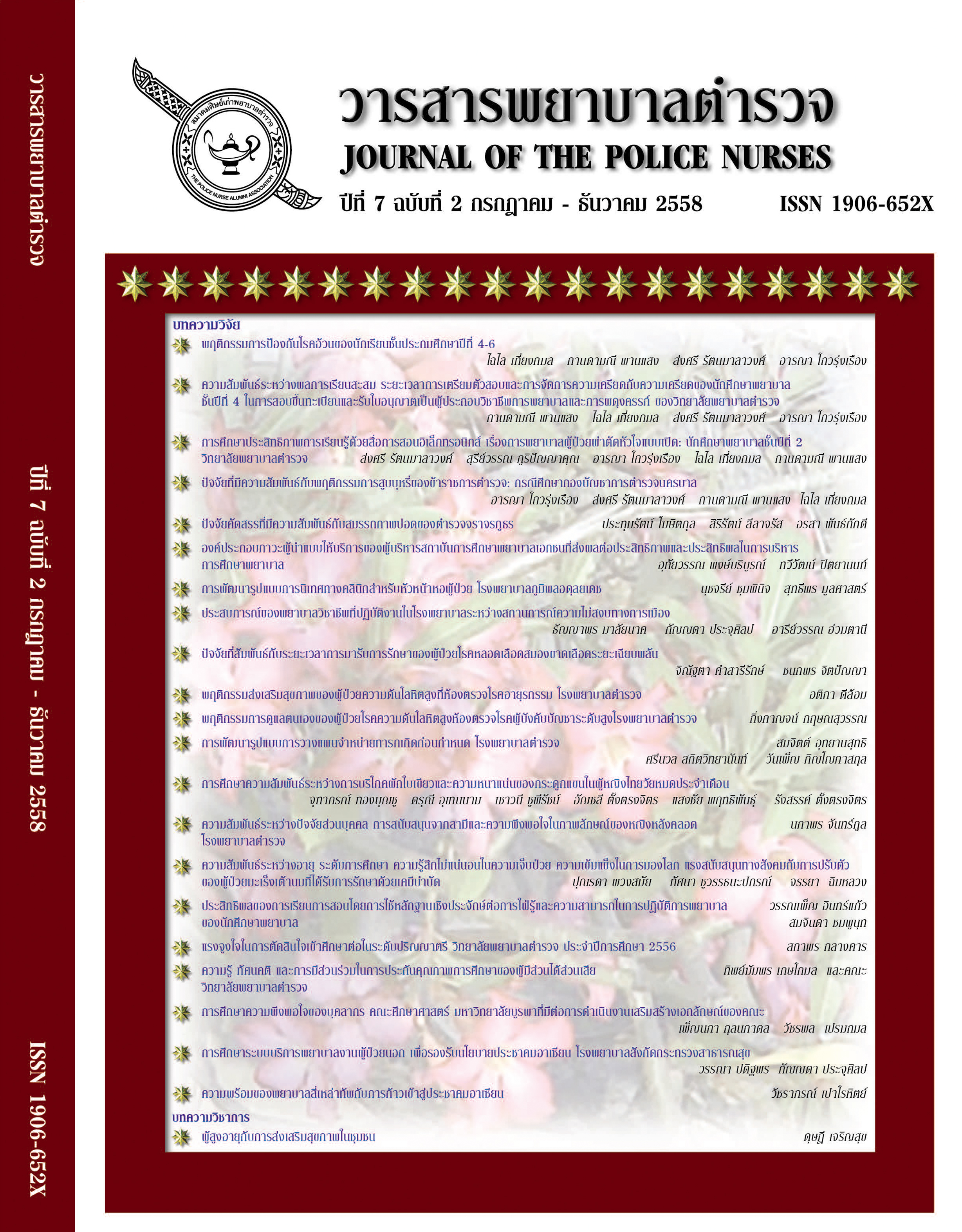พฤติกรรมการป้องกันโรคอ้วนของนักเรียนชั้นประถมศึกษาปีที่ 4–6
Keywords:
พฤติกรรมการป้องกันโรคอ้วน, การรับรู้ความสามารถตนเอง, ความคาดหวังในผลลัพธ์การปฏิบัติตัว, Obesity prevention behavior, Self-efficacy, Student performance expectationAbstract
บทคัดย่อ
การวิจัยครั้งนี้เป็นการวิจัยเชิงพรรณนา (Descriptive Research) โดยมีวัตถุประสงค์เพื่อศึกษา 1) ความรู้เกี่ยวกับโรคอ้วน การบริโภคอาหาร และการออกกำลังกาย การรับรู้ความสามารถตนเอง ความคาดหวังในผลลัพธ์ของการปฏิบัติตัว และพฤติกรรมการป้องกันโรคอ้วนของนักเรียนประถมศึกษาปีที่ 4-6 โรงเรียนในสังกัดสำนักงานเขตพื้นที่การศึกษาประถมศึกษา และ 2) ความสัมพันธ์ระหว่างปัจจัยทางชีวสังคม ความรู้เกี่ยวกับโรคอ้วน การบริโภคอาหารการออกกำลังกาย การรับรู้ความสามารถตนเองของนักเรียน ความคาดหวังในผลลัพธ์ของการปฏิบัติตัวของนักเรียนกับพฤติกรรมการป้องกันโรคอ้วนของนักเรียน ตัวอย่างทั้งหมด จำนวน 400 คน เป็นนักเรียนประถมศึกษาปีที่ 4-6 ภาคเรียนที่ 2 ปีการศึกษา 2557 โรงเรียนในสังกัดสำนักงานเขตพื้นที่การศึกษาประถมศึกษาเขต 1 จำนวน 8 โรงเรียน สุ่มตัวอย่างแบบหลายขั้นตอน (Multi-Stage Sampling) เครื่องมือที่ใช้ในการเก็บรวบรวมข้อมูลเป็นแบบทดสอบความรู้เกี่ยวกับโรคอ้วนซึ่งเป็นแบบเลือกตอบ 4 ตัวเลือก แบบสอบถามการรับรู้ความสามารถตนเอง แบบสอบถามความคาดหวังในผลลัพธ์ของการปฏิบัติตัว และแบบสอบถามพฤติกรรมการป้องกันโรคอ้วนของนักเรียน ลักษณะคำถามเป็นแบบมาตราส่วนประมาณค่า(Rating scale) ตรวจสอบคุณภาพเครื่องมือโดยหาความเที่ยงตรงตามเนื้อหา เลือกข้อคำถามที่มีค่า IOC (Index of item objective congruence) อยู่ระหว่าง 0.5-1 และหาค่าความเชื่อมั่นของแบบสอบถามความรู้เกี่ยวกับโรคอ้วน พฤติกรรมการรับประทานอาหาร และพฤติกรรมการออกกำลังกาย การรับรู้ความสามารถตนเองความคาดหวังในผลลัพธ์ของการปฏิบัติตัวของนักเรียน และพฤติกรรมการป้องกันโรคอ้วน เท่ากับ 0.88, 0.81, 0.86, 0.91 ตามลำดับ สถิติที่ใช้ในการวิจัย ได้แก่ การแจกแจงความถี่ ร้อยละ เฉลี่ย ส่วนเบี่ยงเบนมาตรฐาน ไค-สแควร์( - test) และสัมประสิทธิ์สหสัมพันธ์ของเพียรสัน (Pearson product moment correlation coefficient)
ผลการศึกษาพบว่า
1. ตัวอย่างส่วนใหญ่มีระดับความรู้เกี่ยวกับโรคอ้วน การบริโภคอาหาร และการออกกำลังกาย อยู่ในระดับปานกลาง (ร้อยละ 61.5) มีการรับรู้ความสามารถตนเองโดยรวมอยู่ในระดับมาก ( = 3.78, SD = 0.42) มีความคาดหวังในผลลัพธ์การปฏิบัติตัวของนักเรียนโดยรวมอยู่ในระดับมาก (
= 4.34, SD = 0.40) และมีพฤติกรรมการป้องกันโรคอ้วนของนักเรียนโดยรวมอยู่ในระดับปานกลาง (
= 1.22, SD = 0.60)
2. ปัจจัยที่มีความสัมพันธ์ทางบวกกับพฤติกรรมการป้องกันโรคอ้วนของนักเรียนอย่างมีนัยสำคัญทางสถิติที่ระดับ .05 คือ อาชีพของผู้ปกครอง การรับรู้ความสามารถตนเองของนักเรียน และความคาดหวังในผลลัพธ์ของการปฏิบัติตัวของนักเรียน ส่วนความรู้เกี่ยวกับโรคอ้วน การบริโภคอาหาร และการออกกำลังกายไม่มีความสัมพันธ์กับพฤติกรรมการป้องกันโรคอ้วนของนักเรียน
Behavior for Obesity Prevention of the Primary Education Students, Grade 4-6
Abstract
The objectives of this descriptive research were 1) to study the knowledge of obesity prevention, eating and exercise behaviors, self-efficacy, student performance expectation, and obesity prevention behavior of grade 4-6 students under the jurisdiction of primary educational service area 2) to find out the relationships between the bio-social factors, knowledge of obesity prevention, eating and exercise behaviors, self-efficacy, student performance expectation and obesity prevention behavior of grade 4-6 students. The samples for this study were a total of 400 Primary Education Students Grade 4-6. in the 2014 second academic semester from 8 schools under the jurisdiction of primary educational service areas. A multistage sampling technique was used. The research instrument was multiple choices test 4 answers such as the obesity prevention knowledge test and the rating scale questionnaire were self–efficacy test, student performance expectation test and obesity prevention behavior test. The content validity value by IOC (Index of item objective congruence) was among 0.5-1.0.The reliability value of the obesity prevention knowledge test, self–efficacy scale, student performance expectation scale, and obesity prevention behavior scale were 0.88, 0.81, 0.86, 0.91, respectively. Statistics used in data analysis were frequency, percentage, mean, standard deviation, Chi-square ( - test) and Pearson’s product moment correlation coefficient.
The research findings were as follows:
1. The knowledge of obesity prevention, eating and exercise behaviors of grade 4-6 students under the jurisdiction of primary educational service areas was at a medium level (61.5%); self –efficacy was at a high level (Downloads
Downloads
Published
How to Cite
Issue
Section
License
ผลงานที่ได้ตีพิมพ์แล้วจะเป็นลิขสิทธิ์ของวารสารพยาบาลตำรวจ















